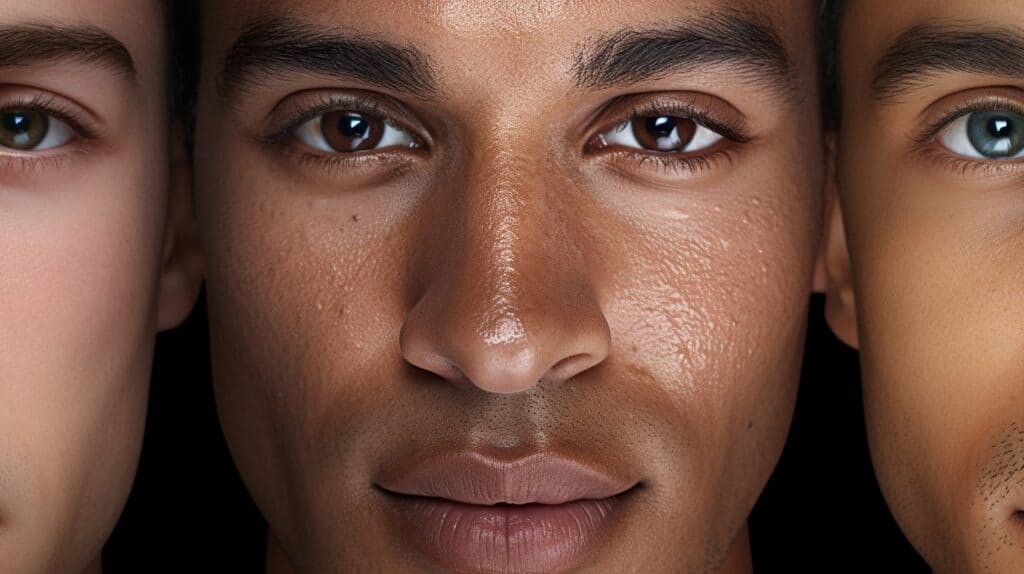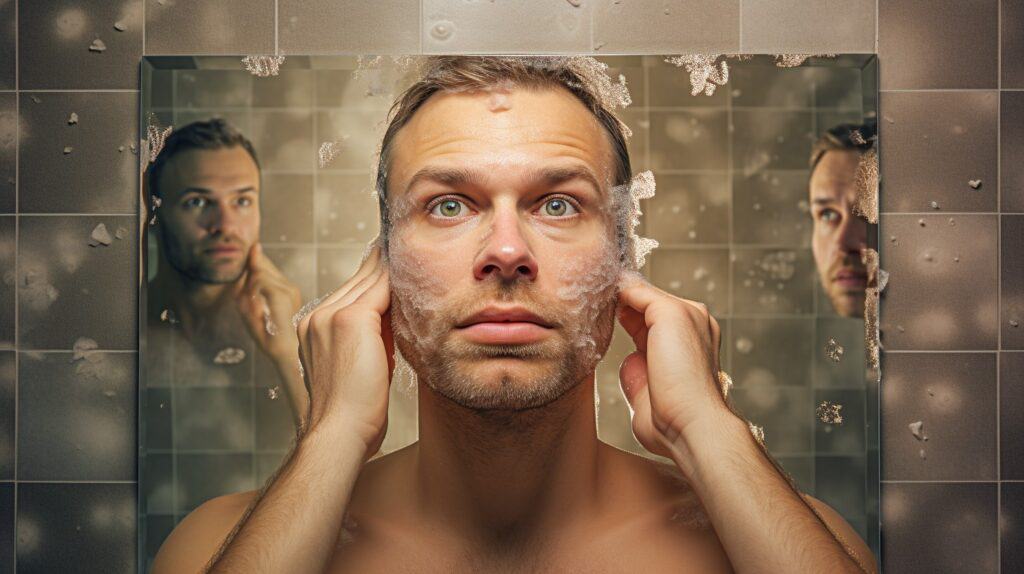Wandering down the skincare aisle, you might feel like you’re trying to crack a secret code, especially when your skin’s needs seem as mysterious as an ancient riddle. I can relate; there was a time when the abundance of choices left me completely flummoxed.
But then I stumbled upon this surprising statistic: 64% of men are just as puzzled about their own skin type. Consider this guide your personal compass, charting a course through the bewildering array of options toward a better understanding of your skin’s unique requirements.
Embark on this journey for enlightenment and step out with newfound self-assurance!
Key Takeaways
Men can figure out their skin type using easy methods like the bare-faced test or blotting paper trick.
Knowing whether you have normal, dry, oily, combination, sensitive, or mature skin helps you choose the right skincare products.
Use gentle cleansers and moisturizers suited to your specific skin type for the best care.
If you need extra help with your skin, a dermatologist is there to give expert advice.
Table of Contents
Understanding the Importance of Knowing Your Skin Type

Skincare isn’t just buying products and hoping for the best. It’s about using the right tools for your specific needs, like picking a hot shaver that suits sensitive skin or finding a moisturizer that tackles dryness without feeling greasy.
If you know your skin type, you can make smart choices. For example, imagine slathering a rich cream on oily skin; it may lead to more shine and pimples. Or picture using harsh exfoliants on delicate faces – ouch! That’s why figuring out whether you have dry, oily, normal, combination, or sensitive skin matters so much.
Let’s get it straight: proper skincare is not an option – it’s essential. Think of your face as a custom project; each detail needs attention based on what works for it. With knowledge comes power—the power to invest in skincare products that work in harmony with your natural biology.
You wouldn’t use heavy body lotion meant for legs on your face now, would you? Understanding sebum production lets men tackle issues like shiny foreheads head-on while hydrating ingredients like hyaluronic acid quench thirsty patches effectively when used correctly.
Your routine should be tailored just for you because every man deserves to feel confident in his own skin.
Identifying Different Skin Types

Let’s dive into the diverse world of men’s skin types, where understanding whether you have normal, dry, oily, combination, sensitive, breakout-prone, or mature skin sets the stage for a personalized skincare regimen.
Normal (Eudermic) Skin
I got lucky with my skin – it’s what you’d call normal or eudermic. That means I don’t struggle with shine on my forehead or dry patches on my cheeks. My pores are small, and I don’t often get blemishes.
It feels good to have balanced skin that’s not too oily or too dry.
Taking care of normal skin is pretty straightforward. I stick to a simple routine using a gentle cleanser and a moisturizing cream that keeps things just right. But even though my skin doesn’t give me much trouble, I never skip the sunscreen; gotta protect against those wrinkles! Now, let’s talk about those who have dry skin and how they can keep their face feeling hydrated and smooth.
Dry (Xerosis) Skin
Now, let’s talk about skin that feels tight and might flake or itch – that’s dry skin for you. If your face feels rough and you see flakes after a wash or feel like your skin is always thirsty for moisture, chances are you’re in the dry skin camp.
This happens when your skin doesn’t hold onto moisture well.
To deal with this, it’s all about keeping things gentle and hydrated. Use products that help keep water in your skin, like moisturizers with humectants. They pull water into the outer layer of your skin from deeper levels and the air around you.
Avoid strong soaps or body washes that strip away natural oils; instead, choose creamy cleansers that can help maintain those necessary oils in sebaceous glands. And remember to be kind to your face by not rubbing hard; patting yourself dry is better to reduce irritation.
Oily (Seborrheic) Skin
Moving from dry skin, let’s talk about oily skin. If your face often looks shiny and you have large pores or get pimples easily, you might have oily skin. This type means your body makes a lot of oil called sebum.
Too much sebum can lead to breakouts and acne.
Taking care of oily skin is all about balance. In the morning, use a cleanser with clay or mild exfoliants to help with the greasiness. Salicylic acid is good, too, because it helps clear your pores.
At night, clean your face twice – first with an oil cleanser and then with a toner that has hazel or salicylic acid in it. Finish off by putting on a water-based gel cream to keep things not too dry but also not too oily.
Combination Skin
Dealing with combination skin can be like having two different faces. My forehead and nose get greasy; that’s the oily part. But then my cheeks and chin feel dry. It’s a classic case of combination skin, where you need special care to keep each area happy.
I have learned not all lotions or facial products work for every part of my face. I use a gentle face wash to cleanse without making the dry spots drier or the oily parts oilier. Then, I treat each area with what it needs: hydration for the cheeks, oil control for the T-zone.
Coming up next is sensitive skin – another type that asks for a soft touch and careful choices in skincare products.
Sensitive Skin
My skin gets upset pretty easily. It might turn red, get bumps, or feel like it’s burning when I’m stressed out, the weather changes, eat spicy food or drink too much coffee. I have to be careful with what I put on my face.
If you’re like me with sensitive skin, we need to steer clear of harsh chemicals in our skincare products and look for gentle stuff instead.
I start every morning by washing my face with a mild milk-based or cream cleanser that doesn’t have any strong smells. This keeps my skin calm. At night, I make sure to use products that soothe my skin so it can recover from whatever the day threw at it.
Next up is breaking down how guys with breakout-prone skin can tackle their own unique challenges.
Breakout-Prone Skin
If sensitive skin requires gentle care, dealing with breakout-prone skin is all about a balancing act. This type of skin often has pimples or acne. It may feel oily in some places and dry in others.
Knowing if your face gets greasy or stays dry can help you choose the right products to keep breakouts away.
For guys battling this problem, it’s smart to look for face washes and lotions made just for acne-fighting. Use a light exfoliator to get rid of dead skin cells that can clog pores – but not too often, as this might make things worse.
Stick to oil-free moisturizers so you don’t add more grease to your already oily areas. Always remember that keeping your skin clean and using the right stuff plays a huge part in waving goodbye to those annoying breakouts for good!
Mature Skin
Taking care of breakout-prone skin is one thing, but as we age, our skin has different needs. With mature skin, we’re dealing with deeper wrinkles and less springiness. Our face might look a bit more tired because it loses some color and doesn’t bounce back like before.
This happens as collagen decreases and cells don’t renew as fast.
To give mature skin what it needs, use products that help rebuild firmness and reduce lines. Look for ingredients like retinol that can boost cell growth or vitamin C to brighten up the complexion.
Keep your skin moisturized because dryness can make wrinkles stand out more. And don’t forget sunscreen; protecting against sun exposure keeps aging signs from getting worse.
Methods to Determine Your Skin Type

Now, if you’re wondering how to figure out where your skin falls on the spectrum, I’ve got some straightforward techniques up my sleeve. First off, we have the Bare-Faced Method — a simple observation-based strategy after cleansing your face and giving it a bit of time to return to its natural state.
Then there’s the Blotting Sheet Method; this one involves pressing different areas of your face with blotting paper and examining which parts leave more oil behind. These approaches are both quick and easy ways for anyone, no matter their skincare experience level, to get insights into their unique skin type without any fuss or muss.
The Bare-Faced Method
Hey guys, let’s talk about figuring out your skin type with something called the bare-faced method. It’s pretty easy. First, you’ll need to give your face a good wash with a gentle cleanser.
This gets rid of any dirt or oil that might mess up your results. Now, wait for about half an hour before you check out your skin again. After those 30 minutes, take a close look at your face in the mirror.
You’re checking to see if there are shiny parts, which means greasy skin or tight spots that tell you it’s dry. Some areas could be fine while others are not so much – that would be combination skin.
If everything feels just right and looks balanced, lucky you – you’ve got what they call normal skin! This method helps us guys figure out our own skincare game plan without fuss or guessing games.
The Blotting Sheet Method
Moving on from the bare-faced way to see what your skin is like, let’s try something different. Get yourself a pack of blotting sheets. These little papers are great for checking how much oil your skin has.
Here’s what you do: press the paper onto different areas of your face and then hold it up to the light. If the sheet picked up oil from all over, that means you likely have oily skin.
Got oil just from your forehead or nose? That could mean combination skin. No oil at all might show you have dry or normal skin.
This method is simple and can help you out fast when choosing products like face wash or exfoliators that match what your skin needs. Remember, knowing whether shine is a big deal for you—or not—can guide you to keep your face looking its best without wasting time or money on stuff that doesn’t work right for you.
Tailoring Skincare to Your Skin Type

Understanding and embracing your unique skin type isn’t just about looking good; it’s a crucial step in maintaining your skin’s health. For those with normal skin, the goal is equilibrium—keeping that perfect balance without overdoing it.
If you’re tackling dryness, hydration is your best friend; think of rich moisturizers and gentle cleansers to quench that thirst. Oily-skinned gents may struggle with excess shine, but with the right oil-free products and regular exfoliation, you can achieve a matte finish.
Combination skin requires a dual approach—address zones separately for harmonized results.
Sensitive skin demands a softer touch; hypoallergenic formulas are key to avoiding irritation. The breakout-prone among us must adopt acne-fighting regimes; salicylic acid could become your new ally against blemishes.
And let’s not forget mature skin—it thrives on anti-aging techniques like retinoids and collagen-boosting ingredients to preserve youthfulness.
Normal Skin: Maintaining Balance
I have normal skin, which means it’s not too dry or oily. It feels pretty good most of the time – soft and smooth. To keep it that way, I stick to a simple routine. Every day, I use a gentle face wash to clean my skin without stripping away its natural oils.
Then, I put on a light moisturizer to keep my skin hydrated.
Taking care of normal skin is all about balance. You don’t want to overdo it with heavy creams or strong soaps that can mess things up. A quick shave in the morning keeps me looking sharp, but I always use a shaving cream that’s kind on the skin.
Sometimes, once a week, I’ll exfoliate with a mild scrub to remove dead skin cells and keep everything feeling fresh.
Dry Skin: Hydration and Care
Maintaining balance for normal skin is one thing, but taking care of dry skin brings its own set of rules. For those with flaky or tight-feeling skin, hydration is key. A daily routine should include products that help your skin hold onto water.
Look for ingredients like aloe, glycerin, ceramides, and hyaluronic acids. These keep your skin soft and reduce itchiness.
Be gentle with how often you wash your face – once a day is enough to avoid stripping away moisture. After cleaning, apply oils such as jojoba oil or sunflower seed oil, which are great at keeping the dryness at bay without feeling heavy on the face.
They provide just the right touch of care to battle rough patches and bring back smoothness to your skin.
Oily Skin: Managing Shine and Oil Control
I have oily skin and know how tough it can be to deal with the shine. My face gets greasy, my pores look big, and I often break out. But I’ve found ways to control that oil and keep my skin clearer.
The trick is using the right products and routines.
For starters, I use a face wash for seborrhea twice a day to clean away oil without drying out my skin. After washing, it’s important not to rub my face hard because this can make more oil come out.
Instead, I pat my face gently with a clean towel. Exfoliating a couple of times a week helps, too; it clears away dead skin cells, which can clog pores if left on the skin.
Next up: dry skin needs special attention!
Combination Skin: Addressing Mixed Concerns
Combination skin can be tricky. You’ve got oiliness on your forehead and nose but dry patches on your cheeks and chin. It’s like a puzzle, right? But don’t worry, I’ve got you covered with some smart moves for this challenge.
First off, go for a gentle face wash that doesn’t strip away moisture. Use it twice daily to keep things clean without irritating the dry areas.
Now, let’s talk about hydration and balance. You’ll want to use two types of moisturizers – a lighter one for those oily spots and a richer cream for the dry zones. And here’s a pro tip: Look out for products labeled “non-comedogenic.” They won’t clog your pores or make the oily parts worse.
Trust me, taking care of combination skin is all about finding that sweet spot between too much and not enough.
Sensitive Skin: Gentle Approaches
If you’ve got sensitive skin, it’s like your face throws a fit with the wrong products. You may notice redness, dryness, or feel itchy and tight. It’s not fun. Stick to gentle stuff; think of using a cream cleanser in the morning instead of harsh soaps.
Look for products with calming ingredients, such as green tea, that won’t make your skin angry.
For night care, keep things mild, too. Some creams are full of fragrances that can upset your skin—skip those. Instead, go for soothing nighttime lotions with helpful stuff like ceramides to help you sleep without skin stress.
And if all this makes you scratch your head wondering what’s best, see a dermatologist who can guide you right.
Let’s move on to tackling another tricky type: breakout-prone skin and how to deal with those pesky pimples without making matters worse.
Breakout-Prone Skin: Acne-Fighting Strategies
I know how tough it can be to deal with skin that always seems ready to break out. For guys like us, we need to pick our battles—and the right products—to keep acne at bay. First off, grab a face wash made just for breakout-prone skin; look for ingredients like salicylic acid that dive deep into pores and help clear them out.
A good face wash can make all the difference.
Next up, let’s talk treatment. It’s not just about washing your face; you’ve got to target those pesky pimples head-on. Liquid salicylic acid comes in handy here, too—it keeps things clean and reduces swelling and redness.
Benzoyl peroxide is another hero fighting against breakouts; it kills bacteria and helps prevent new spots from popping up. And don’t skip on moisturizing—do it morning and night even if your skin is oily because keeping your skin hydrated actually helps control oil better in the long run.
Now, let’s move on to something equally important: finding ways to take care of mature skin.
Mature Skin: Anti-Aging Techniques
Taking care of mature skin means fighting the signs of aging. You can look for products with retinol and hyaluronic acid. These ingredients can help your skin look younger. They work by making fine lines less visible and adding moisture to your skin.
Always use sunscreen, too, because it protects your skin from sun damage that makes you look older.
A good face wash is key in every skincare routine, especially with mature skin. It keeps things clean without drying out your face. Now, let’s talk about how all men, no matter their skin type, should start with a basic skincare routine.
General Skincare Tips for All Skin Types

Whether you’re sporting normal, dry, or oily skin, there’s a universal skincare playbook to keep your face in the game. From nailing down a basic routine to mastering the art of exfoliation and finding your perfect shave, I’m here to help you unlock the secrets of all-star skin maintenance.
Ready for more? Keep reading!
Starting with a Basic Skincare Routine
Hey guys, let’s talk about kicking off a basic skincare routine. First things first, you’ll need a good face wash that matches your skin type. If you’re not sure where to start, pick one labeled for all skin types; these are usually gentle and a safe bet.
Wash your face twice a day – morning and night. It helps get rid of dirt and oil without making your skin too dry.
After cleaning your face, it’s time to moisturize. Even if your skin is oily, don’t skip this step! Find a light moisturizer that won’t clog pores or leave you feeling greasy. A dime-sized amount can go a long way in keeping your face smooth and hydrated all day long.
Simple routines like this are the backbone of great skincare – they lay the groundwork for everything else you do to take care of your face.
The Role of Toner, Face Masks, and Scrubs
Once you’ve got the basics of skincare down, it’s time to look into toner, face masks, and scrubs. Toner is like a double-check for your skin. After washing your face, swipe some on with a cotton pad.
It takes away any oil or dirt that might still be there. This leaves your skin extra clean and ready for moisturizer.
Now, let’s talk about face masks and scrubs. Think of face masks as a special treat for your skin. They can suck out dirt from deep in your pores or give you a big boost of moisture—whatever your face needs at the moment! Scrubs are here to help, too; they buff off dead skin cells so new ones can come in and make everything smooth again.
Just remember not to scrub too hard or too often—it’s better to be gentle with your skin.
Shaving Tips for Sensitive Skin
After talking about toners and scrubs, let’s move on to shaving, which can be rough on sensitive skin. If your face gets red or stings after shaving, you might have sensitive skin.
To help with this, prep your face with Hybrid Glide Shave Oil first. This oil makes a slick layer that helps your razor slide smoothly and protects your skin from getting angry.
Now put on some Smooth Brushless Shave Cream. It adds more protection and helps the razor move easily without bumps or cuts. After you shave, don’t just walk away; use Instant Relief Aftershave right away.
It keeps the redness and itch away and stops those little bumps from showing up. Your shaved skin will thank you for treating it kindly!
Ready For Healthier Skin?

Figuring out your skin type can really change the game for your face. Once you know, you can pick the right products and care for your skin better. Remember to try out those simple tests like the bare-faced or blotting paper method to get started.
Take care of that face, and it will thank you by looking great! And hey, if you ever feel stuck, a dermatologist can help sort things out, too.
How can I tell what skin type I have?
You can find out your skin type by looking at how much oil or dryness you see on your face a few hours after washing.
What should men do to figure out if their skin is dry?
Men can check for flaky or tight-feeling skin, which often means it’s dry. Using a gentle face wash and not seeing oil might also show that your skin is dry.
Why is knowing my skin type important?
Knowing your skin type helps you choose the right products, like face wash, so you don’t make your skin too oily or too dry.
Can my skin type change over time?
Yes, things like weather or age can change your skin from oily to dry or in-between.



